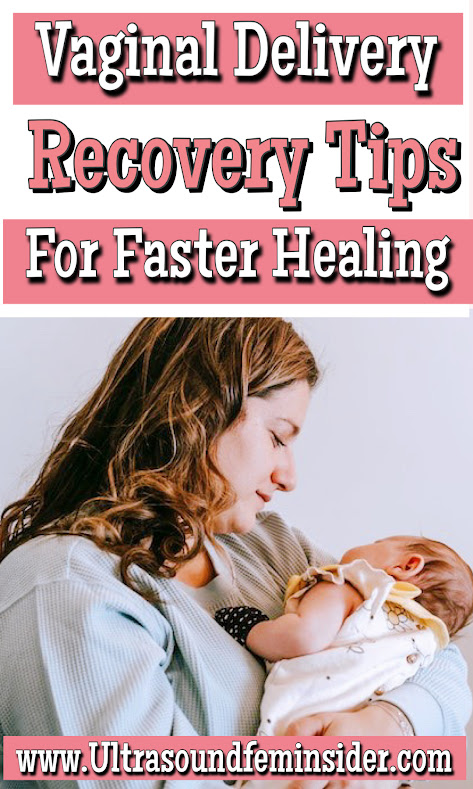When a woman gives birth through the vagina, this type of birth is referred to as a vaginal delivery. The vast majority of births now take place via vaginal delivery, which is also the method that is most preferred. This is due to the fact that they often carry a low risk and offer the most benefits to both the mother giving birth and the newborn. However, although Vaginal delivery is less complicated than having a C-section it still may cause injuries to the peritoneum, bruises, Vaginal tearing etc. Therefore, in this article I am going to give you important Vaginal Delivery Recovery Tips for Faster Healing so you can enjoy your life as a new mom as soon as possible. Ready? Let’s begin.
What are the different kinds of vaginal births that can occur?
There are three distinct varieties of vaginal births: natural, medically aided, and medically induced.
- A vaginal delivery that occurs on its own and without the use of medicines to induce labor is referred to as a spontaneous vaginal delivery.
- Induced vaginal birth involves the use of medications or other procedures to start labor and get your cervix ready for delivery. Induction of labor is another name for this process.
- A vaginal birth that is assisted by the use of instruments such as forceps or a vacuum device to assist in the delivery of the baby is referred to as an assisted vaginal delivery. It is possible to provide assistance for either a spontaneous or induced vaginal birth.
What are the steps involved in giving birth using the vaginal route?
There are three stages that may be distinguished in a vaginal delivery: labor, the birth itself, and the delivery of the placenta.
Labor:
Uterine contractions are what kick off the first stage of labor, which lasts until your cervix is 10 centimeters dilated and you’ve reached 100 percent effacement.
There are three stages of labor: the early stages, the active stages, and the transitional stages.
- Early labor: Is the stage of labor that begins when contractions start, and your cervix begins to thin out and open (dilate) (efface). At the end of early labor, your cervix may be approximately 5 centimeters dilated at the most.
- Active Labor: During this stage of labor, the woman will experience intense contractions that can last up to one minute each and occur approximately three minutes apart. Due to the excruciating pain associated with contractions, some expectant mothers opt to have an epidural administered during this period. To hasten the process of labor, medical professionals may also provide oxytocin in the form of Pitocin.
- Transitional Labor: When you are at this stage, your cervix has not yet dilated to a depth of 10 centimeters. When contractions come on extremely rapidly and continue for more than a minute, you are entering a period of time that is brief but strong. It’s possible that this phase will cause you to sweat, throw up, or feel wobbly. It occurs right before you start pushing the baby out.
Actual Birth:
When your cervix measures 10 cm, you will enter the birthing stage. The birthing stage will conclude when your baby is delivered through your vagina. During this stage of labor, you will begin pushing and will be experiencing intense contractions. You may feel pressure or like you need to poop. In the event that you have received an epidural and are unable to feel the contractions, your healthcare practitioner may guide you through the pushing phase of labor. This stage could last anywhere from a few minutes to several hours. If you’ve already given birth vaginally before, the second time around should go more quickly.
And Finally Placental Delivery:
The delivery of the placenta marks the culmination of the laboring process (commonly called afterbirth). The process starts once your kid has been extracted from your vagina and continues until your placenta has been delivered. It’s possible that your healthcare practitioner will ask you to give it a couple more pushes. This stage starts a few minutes after your baby is born and can last for up to half an hour after they are delivered.
It is essential to keep in mind that labor and deliveries are unique experiences for each individual. There are a number of factors that can influence the length of time that your labor lasts. If you get an epidural, for instance, you won’t feel the same level of agony as a person who doesn’t get an epidural during their labor and delivery. It’s possible that your labor will last longer if this is your first child. The duration of a vaginal birth can be affected by a variety of factors, including the size and position of the baby, as well as how quickly the mother dilates.
What are the benefits of giving birth vaginally?
Both the individual giving birth and the fetus stand to gain from a vaginal delivery in a number of important ways.
Advantages of having a vaginal delivery for Moms:
- Less time spent recuperating.
- Earlier onset of lactation.
- Reduced risk of having complicated pregnancies in the future.
Advantages that vaginal delivery for Babies:
- Reduced likelihood of developing respiratory problems.
- Enhanced capabilities of the immune system.
- Higher likelihood of breastfeeding.
How long does it take for a woman to fully recover from having a vaginal delivery?
The amount of time needed to recover after giving birth vaginally can vary. Healing time following a vaginal delivery is typically shorter than that following a C-section delivery. There are a number of things that can affect how quickly you recover.
One of these is whether or not your vagina tears, as well as the severity of that tear. If you’ve torn something, you might feel pain for a few weeks thereafter. It may be painful to do activities of daily living such as sitting, standing, or even going to the restroom. In the area of the tear, it is typical to suffer swelling as well as itching. Regardless of whether or not the vaginal lining was torn, the majority of people will have bruising, swelling, and general discomfort in their vaginal region for a week or two.
Share the post!

Vaginal Delivery Recovery Tips for Faster Healing.
1. Use the Perineal spray
During those trying first few days after giving birth, this calming perineal spray, which is made with organic herbs, can be a great aid in providing comfort and relaxation. Additionally, it has a naturally cooling quality, thus employing it whenever necessary results in a revitalizing experience for the user.
2. Sitz bath is very helpful
After giving birth, if you are looking for a way to speed up the healing process of your sutures, a sitz bath is the answer. If you want your perineum to recover more rapidly, you can try a sitz bath, which involves immersing it in water. In preparation for this, you should first ensure that your bathtub is free of any filth or bacteria that may be present, this is extremely important to avoid infections.
Those who give birth vaginally absolutely can benefit from sitz bath because it was created specifically to provide comfort and aid in the healing of the intimate areas of the body. In order to get the highest level of healing and recuperation, combine it with organic and natural sitz bath tablets.
This Sitz bath salt is ideal for promoting wound healing and treating hemorrhoids after surgical procedures. You may also try using standard Epsom salt and incorporating aromatic scents into the atmosphere of the room in order to help you relax even further.
3. Use Ice packs
If you want a calming sensation, you may either apply it to your underwear or place it in your perineum. You may either buy ice packs plus pads that are already prepared for usage like these, or you can make your own by soaking postpartum pads in water and aloe, and then freezing them until you are ready to use them.
Your perineum will feel less swollen and painful as a result of the application of the cold pack, which also helps to lessen the overall edema in the area. After giving birth, you will unquestionably find it helpful to have these things ready and waiting for you at home.
4. A donut-shaped cushion
If you suffer from ripping during delivery, develop hemorrhoids, or are looking for additional support, you might want to think about obtaining a donut cushion to assist ease the pressure off of your sensitive bits and parts while you are recovering from giving birth.
5. Use a peri bottle
These are small bottles that can be used to spray water on your vaginal area. When you go to the bathroom, the acidic part of your urine makes the tears and scars in your perineum itch and hurt. It also helps keep the area clean and fight off any infections. You might want to add witch hazel to your peri bottle because it is soothing and helps reduce inflammation.
6. Do Kegel Exercises
Kegel exercises are something you should start performing as soon as you feel ready after giving birth because your pelvic floor will be weaker after delivery. This is especially important to keep in mind if you are concerned about your sexual health and are looking for ways to get your strength back after giving birth.
Kegel exercises are an efficient method for getting your vagina back into shape and also for having better control of your bladder. Kegel exercises can be found online or in fitness magazines. You are free to begin the activity whenever it best fits into your schedule.
Before beginning the workout, you should first ensure that your bladder is empty. After that, contract the muscle in the pelvic floor and hold the position for three to five seconds. After that, relax the muscles as much as possible. This should be done ten times. The fact that you can perform this exercise at any time and in any location is undoubtedly the activity’s most notable benefit.
If you can’t do 10, go easy on yourself and give yourself a break. You will gradually regain your strength if you perform as many as you are able to.
7. Practice Moderate Exercise.
After giving birth, you should avoid strenuous exercise for at least a few months at the very least. In the interim, you could begin a light to moderate kind of exercise such as walking.
Regular moderate exercise not only improves blood circulation but also alleviates digestive issues like gas and constipation. Regular light exercise is beneficial for both the toning and strengthening of your muscles.
In addition, physical activity improves your mood and makes you more resistant to stress. This is a terrific technique to help counteract the feeling of being overwhelmed that a lot of new mother’s experience in those first few months after giving birth.
What to do and what not to do to after a Vaginal Delivery.
- It’s not fun to have to go to the bathroom after giving birth. Do not use force when you have to go to the bathroom, or you could hurt your perineum. Eat foods with lots of fiber and drink a lot of water to make it easy to go to the bathroom. You can ask your doctor for a stool softener if you need one.
- Do keep your appointments with the doctor. So, the doctor can make sure that your body is healing properly after giving birth.
- Use cotton underwear because it lets air flow better.
Related Posts you might want to read!
C-Section Recovery Tips to Heal Faster.
Postpartum depression. Causes, symptoms and prevention.
How to Get Rid of Loose Skin After Pregnancy Without Surgery.
Final Thoughts about Vaginal Delivery Recovery Tips for Faster Healing.
The amount of time necessary for a person to heal after having a vaginal birth differs from person to person. It depends on how easy or difficult the birth was, as well as the general capacity of your body to recover from the experience. In most cases, the healing phase lasts for either six weeks or one and a half months. During this time make sure you get lots of rest so that you can get better as quickly as possible. When you have a new person to take care of, it’s conceivable that you won’t be able to sleep whenever you feel like it anymore. To make the process of getting better less difficult, you should look into getting some assistance.
Zadi, xo
Disclaimer: The medical information on this post is for educational and entertainment use only. Under no circumstances, this information is to replace your doctor’s advice or to treat any disease. For proper care, always visit your doctor.









